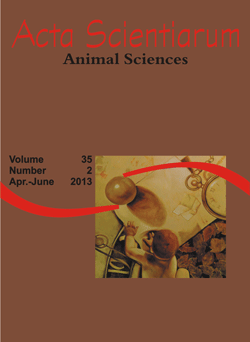<b>Genetic monitoring by rapd markers for repopulation programs of <i>Salminus brasiliensis</i> (Pisces, Characiformes)</b> - doi: 10.4025/actascianimsci.v35i2.15904
Abstract
The preservation of the genetic variability of hatchery stocks used to supplement natural populations is a priority. Current study employed RAPD markers to examine the genetic diversity of dourado samples from the middle Paranapanema river and from the broodstock used in the stock enhancement program of the Aquaculture and Hydrobiology Station at the Salto Grande Hydroelectric Power Plant. Nineteen RAPD primers were analyzed, which generated 299 bands and the latter were used for genetic analysis. The percentage of polymorphic fragments was higher in stock captured in the Paranapanema river than from fry stocks. The genetic diversity was lower in the broodstock than in natural population. Amova results showed that most inter-population genetic variation lay within stocks (83.9%) and not between them (16.1%). Moderate genetic differentiation (FST = 0.16) was reported. Nevertheless, differentiation decreased when the four fry stocks were mixed and analyzed as a single population (FST = 0.07). Instead of releasing each lot separately into the water, mixing specimens produced in the various fry stocks before releasing them in the river would be more feasible. The restocked population will have a genetic structure closer to natural populations.
Downloads
DECLARATION OF ORIGINALITY AND COPYRIGHTS
- I Declare that current article is original and has not been submitted for publication, in part or in whole, to any other national or international journal.
The copyrights belong exclusively to the authors. Published content is licensed under Creative Commons Attribution 4.0 (CC BY 4.0) guidelines, which allows sharing (copy and distribution of the material in any medium or format) and adaptation (remix, transform, and build upon the material) for any purpose, even commercially, under the terms of attribution.
Read this link for further information on how to use CC BY 4.0 properly.








































